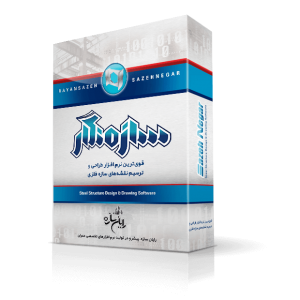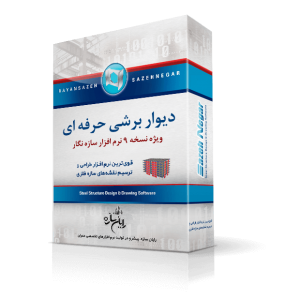توضیحات
پکیج دیتیل ها و طراحی سازه فولادی به روش LRFD
EARTHQUAKE-RESISTANT-STRUCTURES
Design, Build, and Retrofit
The highly nonlinear behavior associated with buckling and nonductile fracture of braces reduces the ability of the special concentrically steel braced frame (SCBF) system to dissipate energy, resulting in undesirable modes of behavior. We analyzed archetype buildings of SCBFs and buckling restrained braced frames (BRBFs). The seismic demands of the system and structuralelements were computed and interpreted for 3-, 6-, and 16-story SCBFs and BRBFs under various hazard levels. The analysis results show large seismic demands for the 3-story SCBF, which may result in unexpected damage of structural and nonstructural elements. We performed evaluations of seismic design parameters for 2-, 3-, 6-, 12-, and 16-story
SCBFs and BRBFs, which demonstrated that short-period braced frame systems, especially SCBFs, had higher probabilities of collapse than longer-period braced frame systems. The
response was substantially improved by lowering the response reduction factor of the 2-story SCBF building; this reduced the collapse risk at the hazard level of 2% probability of exceedance in 50 years. The investigation of system performance and member behavior provides seismic demands to more accurately assess the socioeconomic losses of SCBFs and BRBFs for performance-based earthquake engineering. Special steel moment-resisting frame (SMRF) systems were once considered to be one of the best structural systems for use in areas of high seismicity. The simple configuration of structural elements and straightforward design criteria of this structural system increased its popularity among engineers, architects, and owners. However, the 1994 Northridge, 1995 Hyogo-ken Nanbu, and other recent earthquakes have shaken the confidence of engineers in these systems due to widespread brittle fractures that occurred in special welded steel beam-to-column Although the resulting guidelines have restored the confidence of engineers and the public in the use of SMRF systems, requirements and restrictions are now more stringent for designs using this structural system, and more rigorous checks are stipulated for quality control to achieve the required ductility of beam-to-column connections. Research on SMRF systems has also demonstrated that very large story drift may occur during a severe earthquake, leading to serious damage to structural and nonstructural components. Because the design of SMRF systems is usually controlled by code-designated story drift limits, the member sizes may be much larger than those designed solely on the basis of force. This has resulted in cost increases and complex construction configurations, and engineers and owners now seek more efficient and economical systems.
The special concentrically steel braced frame (SCBF) system is one of the candidates that are simple to design, effective in resisting lateral forces, and efficient in limiting lateral
deformation. Currently, SCBF systems make up about 40% of the market for office and hospital buildings in California, and the trend is believed to be increasing [Ferch 2004]. Although SCBFs are now widely used, damage to concentrically braced frames observed during past earthquakes, including the 1985 Mexico [Osteraas and Krawinkler 1989], 1989 Loma Prieta [Kim and Goel 1992], 1994 Northridge [Tremblay et al. 1995; Krawinkler et al. 1996], and 1995 Hyogo-ken Naubu [Architectural Institute of Japan 1995; Hisatoku 1995; Tremblay et al. 1996] events, should be noted. The failure mode generally observed was fracture of the braces at the locations of local buckling or plastic hinges. In some cases, fractures were observed at the weld of the connections to the gusset plate or the weld in the boundary of the gusset plates. Research demonstrated that this structural system is prone to concentrating the damage to a single story, which results in significant story drift and floor acceleration [Khatib et al. 1988], and design codes have been updated to reduce such common forms of damage.
Despite these code updates, the seismic performance of concentrically braced frames is not considered as robust as it should be. Several factors may degrade the performance of SCBF
systems:
• Braces dissipate energy by yielding in tension and by inelastic buckling in compression. Buckling of braces often decreases their ductility and energy-dissipating capacity under
cyclic loading [Black et al. 1980; Tang and Goel 1989; Kim and Goel 1992]. It is observed that braces fracture after only a few cycles due to the limited ductility capacity.
• The nonlinear behavior of braces as well as braced frames is complex. Therefore, the intensity and distribution of forces, and deformations over the building are difficult to predict numerically. The failure of braces can result in large story drift and frame instability. Some damage occurs because of the unexpected concentration of deformation
or force at a few stories [Aguero et al. 2006].
• There are a variety of failure modes for SCBF systems. From the observations of previous earthquakes and experiments, damage occurs in braces, gusset plates, beamcolumn connections, brace-to-framing connections, and beams and columns. The occurrence of failure modes is sensitive to characteristics of earthquakes, structural
configurations, proportions of structural members, and detailing of the connections. Several experiments have been conducted in recent years to assess the seismic responses
of concentrically braced frame systems. Despite the available experimental and field data, it is difficult to establish confidence in current design methods. Research efforts have long strived to develop quantitative probabilistic methods to evaluate the performance of structures [Hamburgeret al. 2003; Moehle et al. 2005]. These are quite versatile in terms of addressing engineeringcentric goals, such as continued occupancy or collapse prevention, or in terms of societal-centric goals such as maximum probable losses (or down time or injuries) over the life of a structure or given the occurrence of a scenario event (see, for example, Miranda and Aslani [2003]). Thus, a significant opportunity exists to validate and improve design methods for concentrically braced frame structures by developing and validating realistic numerical models and using these models in combination with modern performance-based evaluation frameworks [Moehle 2003]. Most previous analytical studies investigated the behavior of structural components in a braced frame or the behavior of tested specimens. Such preliminary studies indicate the need for additional system studies. Studies are still limited regarding system performance [Uriz and Mahin 2008]
OBJECTIVES
The objectives of this study were to:
• Investigate the sensitivity of global and local engineering demands to parameters used in the design and analysis of concentrically braced frames
• Develop further understanding of the seismic behavior of concentrically braced frame systems in terms of the engineering demand parameters
• Use performance-based evaluation concepts to understand the trade-offs between the stiffness, strength, and ductility, and the global and local demands associated with various performance goals The objectives were achieved by:
• Evaluating and improving numerical models to predict the response of concentrically braced frames consistent with the efficiency and accuracy needs of performance-based
earthquake engineering (PBEE)
• Studying the sensitivity of seismic demands to seismic hazard and structural characteristics
• Examining various engineering demand parameters to characterize performance
• Applying a probabilistic PBEE framework to the assessment of structural performance
• Assessing the design parameters of current codes for steel braced frames using the methodology of FEMA P695 (ATC-63)
• Identifying the global and local seismic demands for performance-based design
• Developing schemes to improve system performance
SCOPE
Performance-based earthquake evaluation criteria have been developed by several researchers to assess the seismic hazard, structural responses, expected damage, and possible losses for various hazard levels and structural systems. Figure 1.1 illustrates the framework of PBEE as developed by the Pacific Earthquake Engineering Research Center (PEER) of the University of California, Berkeley [Moehle 2003]. By constructing an appropriate conditional probability function, the relationship between ground motion intensity and socioeconomic variables is established using the total probability theorem The engineering demand parameter (EDP) model relies on extensive numerical simulations to characterize the relationship between the intensity measure and the EDPs. The damage model, which relates the EDPs to the damage measures, is usually constructed by summarizing the observations from test data and field work to relate EDPs to damage. The loss model defines the relationship between the damage measure and the decision variables, which are usually expressed in terms of death, dollar losses, and downtime; the construction of this model requires efforts from industry to help estimate the possible losses. The research presented here emphasizes the demand model for braced frame systems. We constructed efficient and accurate nonlinear numerical models, and then carefully calibrated them with existing test data for braces and two-story braced frames. To determine the accuracy of the extensive nonlinear dynamic analyses performed for simulations for system behaviors, we compared the results for system performance of the numerical models with results from a more sophisticated but more computational expensive finite-element model, which has been proved to accurately simulate global and local failure of braced frames.









نقد و بررسیها
There are no reviews yet